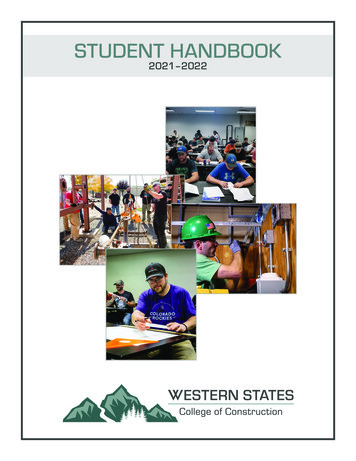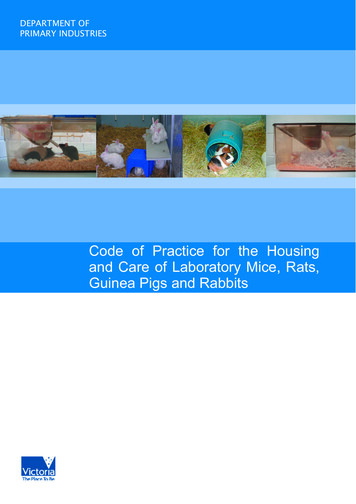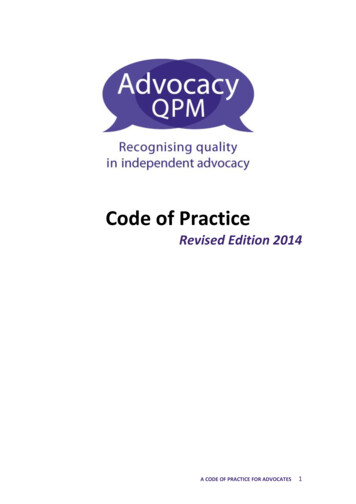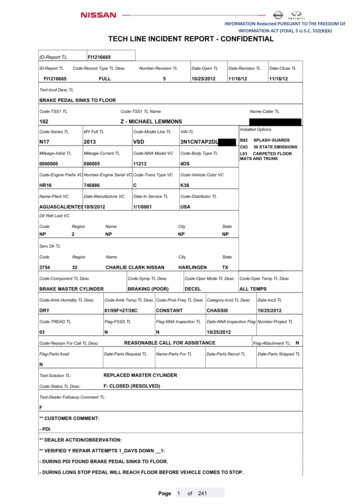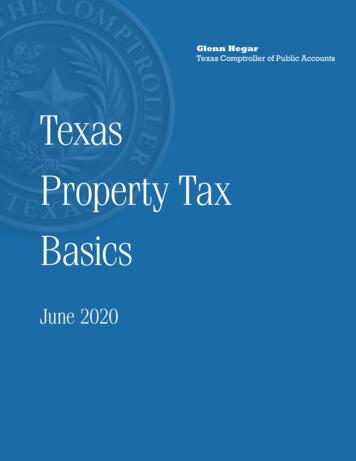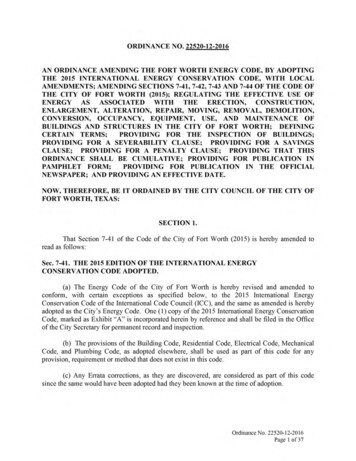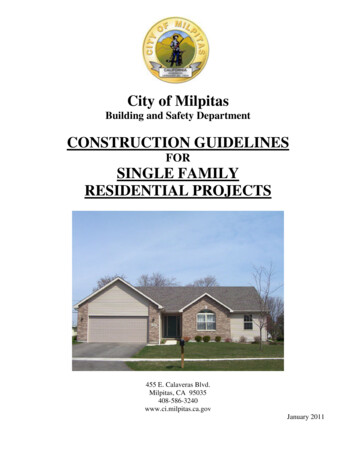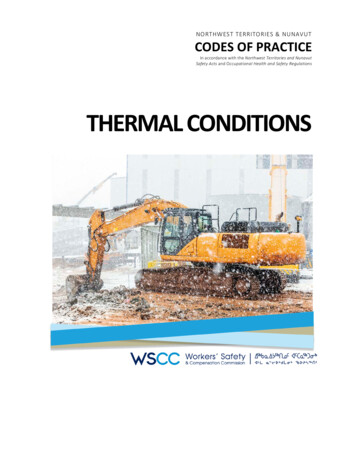
Transcription
NORTHWEST TERRITORIES & NUNAVUTCODES OF PRACTICEIn accordance with the Northwest Territories and NunavutSafety Acts and Occupational Health and Safety RegulationsTHERMAL CONDITIONS
Code of PracticeTHERMAL CONDITIONSNORTHWEST TERRITORIESwscc.nt.caYellowknifeBox 8888, 5022 49th StreetthCentre Square Tower, 5 FloorYellowknife, NT X1A 2R3WHAT IS A CODE OF PRACTICE?Telephone: 867-920-3888Toll Free: 1-800-661-0792Fax: 867-873-4596Toll Free Fax: 1-866-277-3677InuvikBox 1188, 85 Kingmingya RoadBlackstone Building, Unit 87Inuvik, NT X0E 0T0Telephone: 867-678-2301Fax: 867-678-2302Codes of Practice come into effect in each territory on the daythey are published in the Northwest Territories Gazette andNunavut Gazette.The Workers’ Safety and Compensation Commission (WSCC)Codes of Practice (COP) provide practical guidance to achieve thesafety requirements of the Northwest Territories and NunavutSafety Acts and related Regulations.Codes of Practice do not have the same legal force as the Acts,the Mining Regulations, or the Occupational Health and SafetyRegulations. A person or employer cannot face prosecution forfailing to comply with a COP. They are considered industry bestpractice and may be a consideration when determining whetheran employer or worker has complied with the Safety Acts andRegulations in legal proceedings.NUNAVUTwscc.nu.caIqaluitBox 669, 630 Queen Elizabeth II WayQamutiq Building, 2nd FloorIqaluit, NU X0A 0H0As per subsection 18(3) of the Northwest Territories and NunavutSafety Acts, “For the purpose of providing practical guidance withrespect to the requirements of any provision of this Act or theregulations, the Chief Safety Officer may approve and issue suchcodes of practice as he or she considers are suitable for thatpurpose.”Telephone: 867-979-8500Toll Free: 1-877-404-4407Fax: 867-979-8501Toll Free Fax: 1-866-979-8501Employers and workers should follow WSCC Codes of Practiceunless there is an alternative course of action that achieves thesame or better occupational health and safety outcomes.A Code of Practice Provides practical guidelines.Adapts to individual work sites.May serve as evidence.Should be followed unless there’s a better way.Copies of this code are available online from the WSCC at: wscc.nt.ca or wscc.nu.caIf you would like this code of practice in another language, please contact us.
FOREWORDThe Workers’ Safety and Compensation Commission (WSCC) produced this industry Code ofPractice in accordance with subsections 18(3) and 18(4) of the Northwest Territories andNunavut Safety Acts.The WSCC would like to thank all participating stakeholders for their contributions to thedevelopment of the Northwest Territories and Nunavut Thermal Conditions Code of Practice.This Code is adapted from the Alberta Best Practice – Working Safely in the Heat and Cold aspublished by Work Safe Alberta. The WSCC gratefully acknowledges the work of OHS Policy andProgram Development Branch, Workplace Standards Policy and Alberta Human Services.The WSCC also acknowledges the Canadian Centre for Occupational Health and Safety (CCOHS),the Canadian Standards Association (CSA), the American Conference of Governmental IndustrialHygienists (ACGIH), Work Safe Saskatchewan, the Occupational Health and Safety Council ofOntario (OHSCO), the Ontario Ministry of Labour, Infrastructure Health and Safety Association(IHSA) and Environment Canada for information used in the Thermal Conditions Code ofPractice.The Thermal Conditions code relates to section 4 and 5 of the Safety Acts, and sections 74, 89,90, 94, 95, 100, 101 and 109, 300 and 307 of the Occupational Health and Safety Regulations.This code is in effect as published in the in the Northwest Territories Gazette and NunavutGazette, in accordance with the Safety Acts and Occupational Health and Safety (OHS)Regulations.IN EFFECT DATES:Northwest Territories: June 1, 2015Nunavut: May 31, 2016REVIEWED AND REVISED: December 15, 2021Chief Safety Officer, WSCCDisclaimerThis publication refers to obligations under the workers’ compensation and occupational health and safety legislation as administeredby the Workers’ Safety and Compensation Commission.To ensure compliance with legal obligations always refer to the most recent legislation. This publication may refer to legislation that hasbeen amended or repealed.Check for information on the latest legislation at wscc.nt.ca or wscc.nu.ca, or contact WSCC at 1-800-661-0792.or contact WSCC at 1-800-661-0792WSCC Codes of Practice Thermal Conditions
TABLE OF CONTENTSFOREWORD. 1TABLE OF CONTENTS . 41INTRODUCTION . 61.1 Exposure to Heat and Cold . 62BODY’S RESPONSE TO COLD AND HEAT . 72.1 Core Temperature . 72.2 Maintaining Balance. 73THERMAL COMFORT . 84ACCLIMITIZATION . 105COLD . 116COLD EXPOSURE SAFETY HAZARDS. 127HEALTH EFFECTS OF EXPOSURE TO COLD . 138COLD EXPOSURE HAZARD CONTROL . 178.1 Engineering Controls . 178.2 Administrative Controls . 188.3 Personal Protective Equipment . 189COLD EXPOSURE GUIDELINES . 2110OCCUPATIONAL EXPOSURE GUIDELINES. 2210.1 Working in Cold Conditions . 2210.2 Application of Cold Exposure Guidelines . 2210.3 Cold Work Warm-Up Schedule . 2311WIND CHILL . 2411.1 Wind Chill Warnings and Adaptation . 2411.2 Wind Chill Calculation Chart . 2511.3 Wind Speed Estimation . 2511.4 Wind Chill Frost Bite Risk. 2611.5 Wind Chill Hazard Controls and Clothing . 2612HEAT. . 2813HEALTH HAZARDS OF EXPOSURE TO HEAT . 2914HEAT EXPOSURE HAZARD CONTROL . 3314.1 Heat Exposure Hazard Control Hierarchy . 33WSCC Codes of Practice Thermal Conditions
14.2 Engineering Controls . 3314.3 Administrative Controls . 3414.4 Personal Protective Equipment . 3515HEAT EXPOSURE GUIDELINES. 3715.1 Humidex . 3815.2 Humidex Based Heat Stress Response Chart . 3915.3 Humidex Based Heat Stress Values . 4015.4 Wet-Bulb Globe Temperature (WBGT) Index. 4116BREAK SCHEDULE FOR WORKING IN HEAT . 4217HEAT STRESS ACCLIMATIZATION GUIDE . 4318CASE STUDIES . 4518.1 Cold Exposure Case Study . 4518.2 Heat Exposure Case Study . 4618.3 Heat Stroke Case Study . 4719COLD STRESS POLICY . 4820HEAT STRESS POLICY . 50DEFINITIONS & ABBREVIATIONS. 52REGULATORY REQUIREMENTS . 55RESOURCES . 57APPENDIX – WEATHER DATA . 59NORTHWEST TERRITORIES . 61Fort Smith . 62Hay River . 63Inuvik. 64Norman Wells . 65Sachs Harbour . 66NUNAVUT . 68Alert. . 69Cambridge Bay. 70Cape Dorset . 71Iqaluit . 72Kugluktuk . 73Rankin Inlet . 745WSCC Codes of Practice Thermal Conditions
1INTRODUCTIONThis code of practice provides basic guidelines to mitigate the occupational health andsafety risks associated with working in hot and cold conditions.While many workplaces can benefit from this information, this code of practice isespecially intended for people who work outdoors. Examples include road paving,construction, power line maintenance, and outdoor municipal work. The code ofpractice may, however, also be helpful to workplaces that have hot indoorenvironments such as kitchens, bakeries, pizzerias or workplaces with cold indoorenvironments like walk-in freezers, meat processing, or cold storage facilities.The approach taken is the standard work site approach to potential hazards andinvolves hazard identification, risk assessment, control, implementation and monitoring.1.1Exposure to Heat and ColdMany jobs in the North involve working in extremely cold temperatures. These jobsinclude winter road construction work and maintenance, air, ground and watertransportation industries, working at mine sites or in the oil and gas industry,exploration work, municipal services such as delivering water and pumping sewage, andtraditional jobs like hunting and trapping.You must also prepare for extreme weather if you work indoors. You have to go to andfrom work, which includes spending some time outdoors. You may have to travel as partof your job. In the North, this often involves travel in light aircraft.In the summer a lot of construction takes place in the North. Heat stress becomes apotential work hazard. Workers might also be exposed to very hot work environmentswhen working beside hot equipment, furnaces, and processes that give off a lot of heatin a closed space.You have to be ready for changes in the weather. Weather in the North can changequickly and often. Hypothermia is a year round concern in view of low watertemperatures, and cold rains, coupled with wind. This makes it important to becontinually aware of the effects of weather and the potential health and safety hazards.6WSCC Codes of Practice Thermal Conditions
2BODY’S RESPONSE TO COLD AND HEAT2.1Core TemperatureYour body works best when it has an internal core temperature of 37 C. Thistemperature is necessary for vital organs to function normally. During a regular day,body temperature may vary by about 1 C depending on the time of day, level of physicalactivity and how you feel.2.2Maintaining BalanceWhen you work in extreme temperatures, your body has to adapt. To maintain aconstant inner body temperature, the body must continually keep or gain heat in coldenvironments and lose heat in hot environments.To stay warm in cold environments, the body: Shivers. The moving muscles help increase heat production. Reduces blood flow to the skin and extremities (hands and feet) to reduce heatloss from the surface.To stay cool in hot environments, the body: Sweats. Evaporating sweat cools the body. Increases blood flow to the skin to speed up the loss of heat from the skin(radiate away the excess heat) if the outside air is cooler.By sweating, shivering, and changing the rate of blood flow, the body can adapt to afairly wide range of temperatures. However, there are limits to what the body can adaptto and its ability to maintain its core temperature can fail.Guidelines and standards have been developed to provide information on how to bestmeasure and control thermal exposure hazards.7WSCC Codes of Practice Thermal Conditions
3THERMAL COMFORTIn Part 6, Thermal Conditions, section 74 of the Occupational Health and SafetyRegulations of the Northwest Territories and Nunavut employers are required to:“provide and maintain thermal conditions, including air temperature, radianttemperature, humidity and air movement, that(a) are appropriate to the nature of the work performed;(b) provide effective protection for the health and safety of workers; and(c) provide reasonable thermal comfort for workers.”Thermal comfort refers to a person’s feeling of comfort, as in not too hot or not toocold. It is important for both well-being and productivity. Workers under stress becomeless tolerant of uncomfortable thermal conditions.Temperature preference also vary between people. Variability in metabolic rates, fitnesslevels, medical conditions, medication usage, ability to acclimatize, level of hydrationand age makes achieving thermal comfort a challenge. This affects how people perceivethermal comfort levels, even if they are doing the same work in the same environment.Factors Affecting Thermal Comfort1. Air temperature. The air temperature can be measured with a thermometer.However, in situations where there is a lot of radiant heat such as direct sunlight, ormachinery it is not always an accurate indication of how hot or cold you feel.2. Radiant temperature. This describes how heat transfers between the body andother objects in the area. Sources can include direct sunlight, machinery thatgenerates heat, hot water, heaters or open flames, furnaces or steam pipes. It is theprocess by which the body gains heat from surrounding hot objects or loses heat tocold objects such as chilled metallic surfaces – without contact with the surfaces.People are most sensitive to warm ceilings and cold vertical surfaces like windows.3. Solar loading. This refers to the temperature at which thermal stress affect buildingsand materials due to solar radiation depending on age, environmental conditions,time of the year, latitude and orientation of buildings or structures.4. Relative humidity. The amount of moisture in the air affect how hot or cold peoplefeel. The warmer the air, the more moisture it can hold. High humidity makes peoplefeel hotter, because sweat does not evaporate off the skin. Cold air with highrelative humidity feels colder than dry air at the same temperature. This is becausehigh humidity in cold weather increases the loss of heat from the body to thesurrounding air.8WSCC Codes of Practice Thermal Conditions
5. Air speed (velocity). Air movement usually cools a person. Air velocity can becreated by a ventilation system or air conditioning system. This can provide coolingrelief in a hot environment as long as the moving air is cooler than the individual.Drafts, especially around head, neck and feet can cause thermal discomfort. In coldsituations, air movement can create wind chill and make you feel much colder thanthe temperature may indicate.6. Metabolic rate. The number of occupants in a room and the amount of activitydone, combined with clothing worn and radiant temperature influences thermalcomfort.7. Physical exertion. How hard you are working influences how hot or cold you feel.Moving around or working generates heat. When working on a very hot day,exertion increases heat stress.8. Clothing. Type of clothing and work required clothing such as chemical protectiveclothing or cold weather gear affect thermal experience. The right clothing can helpyou stay warmer. However, when mist, rain or sweat is heavy enough to make yourclothing wet, you feel colder. This happens because wet clothing loses its insulatingproperties.Canadian Standard, CSA Z412-17 Office Ergonomics – An application standard forworkplace ergonomics recommends the following for office temperatures: Summer conditions:Optimum temperature of 24.5 C with an acceptable range of 23-26 C Winter conditions:Optimum temperature of 22 C with an acceptable range of 20-23.5 CRelative humidity levels below 20% can cause discomfort due to drying eyes and skin.Relative humidity levels above 70% may cause condensation and mould to develop.Source: Canadian Centre for Occupational Health and Safety CCOHS (2018). Thermal Comfort for Office Work9WSCC Codes of Practice Thermal Conditions
4ACCLIMITIZATIONPeople can adapt to different temperatures through a process called acclimatization. Atthe workplace, acclimatization is important because it allows you to work more safelyand efficiently. However, becoming acclimatized takes time.Acclimatization ProcessEach person must be monitored to ensure he or she is adapting to working at differenttemperatures. When working in new conditions, people need at least four to sevenworking days to acclimatize, but the process may take up to three weeks.A scheduled exposure is recommended and an employer should prepare anacclimatization plan according to exposure guidelines for new or experienced employessif cold or heat stress is a risk factor. More specific detail on acclimatization andrecommended exposure guidelines are in each of the Cold and Heat sections.Physical Conditions Affect AcclimatizationEvery person is different. People who are in good health and physically fit tend to adjustfaster and easier. However, some individuals may not be able to fully acclimatizeregardless of their health or physical condition. People may also have an underlyingcondition, such as coming down with a flu or cold, which affects how their body reactsto the temperature.Body weight, fitness level and age influence the body’s ability to maintain a goodinternal temperature balance and affect responses to cold or heat.Medical conditions can increase how susceptible the body is to heat and cold. Peoplewith heart disease, high blood pressure, respiratory disease and uncontrolled diabetesmay need to take special precautions. People with skin diseases and rashes may bemore susceptible to heat, while people with Raynaud's syndrome, also known as whitefinger disease, will be more affected by cold.Medications also affect how you adapt. Check with your health practitioner to learnwhether medications you are taking may have adverse effects under conditions of heatstress or cold stress. Psychoactive agents, such as antidepressants, can make peoplemore susceptible to both heat and cold, whereas insulin and anti-thyroid drugs maycause more sensitivity to cold.Substances impact how people react to heat and cold. Caffeine and smoking impactmetabolic processes. Alcohol make people more susceptible to both heat and cold.10WSCC Codes of Practice Thermal Conditions
5COLDCold is a physical hazard in many work sites. When the body is unable to warm itself,cold related illnesses and injuries happen. Exposure has mental and physical effects.Nowhere is this of greater concern than in Canada’s Far North. The NorthwestTerritories and Nunavut are two of the coldest locations in Canada.The coldest wind chill in Canada: January 13, 1975, at Kugaaruk,Nunavut. The air temperature was -51 C with 56 km/h winds, producing awind chill of -78!Source: Environment Canada (2014), Wind Chill: The Chilling FactsExtreme cold and environmental factors related to working in northern locations arepotentially hazardous to health and safety. It is necessary to identify the hazards, assessthe potential risk to workers, and develop and implement controls to mitigate thehazards inherent with working in cold conditions.It is important to plan and take precautions and always watch out for signs of unusualbehaviours in yourself and co-workers. These are indicators the person is not copingwell with the temperature and their condition should be investigated.Indicators include:Mental ChangesLoss of alertness, slurred speech, fatigue, lethargy or apathy.Physical ResponsesGeneral discomfort and a loss of sensitivity and dexterity in fingers, hands andtoes. At low temperatures, deep muscles can be affected, reducing musclestrength and flexibility.Also important is to consider that measures taken to mitigate cold exposure harms maybring about other hazards, such as clothing caught in machinery or carbon monoxide(CO) poisoning when using heaters in vehicles or fuel burning equipment in an enclosedspace to warm up from the cold.11WSCC Codes of Practice Thermal Conditions
6COLD EXPOSURE SAFETY HAZARDSPotential cold exposure safety hazards are listed below. The information is drawn fromthe Canadian Centre for Occupational Health and Safety (CCOHS) Cold Weather SafetyGuide and many reputable cold weather information sources listed in the referencesection. But the list may not cover all circumstances.Assess Cold Exposure Hazards Specific to the Work Site and the Weather Conditions!“Mild cold impairs nerve function and lessens sensation and manualdexterity. The critical air temperature for manual dexterity is 12 C and fortouch sensitivity 8 C.”Source: Work Safe Alberta (2014), pg. 52, Best Practice - Working Safely in Heat and Cold Cold affects dexterity, affecting skill and ease of using the hands. In the cold the mobility of fingers slows down, which affects task performance. Cold affects grip force and the skin's ability to sense temperature and pain. Cold exposure reduces muscle power and time to exhaustion. Cold exposure aggravates vibration, inducing white finger disease, which makesmanual work painful. Extremely cold conditions adversely affect mental skills and coordination. Special care is needed while using ladders or working on elevated platforms in snowand icy conditions. Power tools and equipment need special care to be operational in a coldenvironment. Heavy snow fall and blizzards can produce very cold conditions and restrict visibility. Winter clothing, head protection, gloves and boots used while working in the coldcan restrict movement and hoods or hats may obstruct side vision. PPE like safety goggles and face shield may fog up when required to use a covid-19mask or when using a balaclava or face cover for protection against the cold. Use of heaters and or fuel burning equipment to prevent frostbite and hypothermiamay cause carbon monoxide (CO) poisoning in enclosed space if not vented outside. Workers in remote areas need to take extra precautions and orient themselves tocold weather operations and emergency survival. Working on ice and frozen bodies of water require ice testing and knowledge of theice bearing capacity.12WSCC Codes of Practice Thermal Conditions
7HEALTH EFFECTS OF EXPOSURE TO COLDCold is a physical hazard. It is necessary to identify the hazards, assess the potential riskto workers, and develop and implement controls to mitigate the hazards inherent withworking in cold conditions at a work site. (See Chapter 8 - Cold Exposure Hazard Control)Guidelines on first aid risk assessment in the First Aid Kits Code of Practice will helpemployers select: Quantity and type of first aid kits, and quantity and level of training offirst aid attendants needed at the work site.ChilblainsChilblains, a mild cold injury, is caused by prolonged and repeated exposure for severalhours to air temperatures ranging from 0 C to 16 C.Signs: The affected area shows signs of redness, swelling, tingling, and pain.Prevention & Cautions: Dress warmly. Follow occupational cold exposureguidelines. Chilblains will usually resolve. Seek medical help if an infectionoccurs.WindburnWindburn happens when the top layer of oil on the skin is removed by cold wind.Signs: Considered a comparatively mild cold injury, resulting in dry, red, sore anditchy skin.Prevention & Cautions: It is best not to scratch or rub the affected skin as thatcan damage the skin. Cover exposed skin. Dress in layers of warm clothing, withan outer layer that is wind-resistant.FrostnipFrostnip is the mildest form of a freezing cold injury. It occurs when ear lobes, noses,cheeks, fingers, or toes are exposed to the cold and the top layers of a skin freeze.Signs: The skin of the affected area turns white and may feel numb. The skinfeels hard but the deeper tissue still feels normal. The affected skin may peel.Prevention & Cautions: Frostnip can be prevented by wearing warm clothingand foot wear. Cover exposed skin. Never rub the affected parts. Ice crystals inthe tissue could cause damage if the skin is rubbed. Do not use very hot objectsto rewarm the area or person.FrostbiteFrostbite is a common injury caused by exposure to cold or by contact with cold objectsand from contact with cooled or compressed gasses. It happens when fluids around thebody’s tissues freeze at temperatures below 0 C. The most vulnerable parts of the bodyare the nose, cheeks, fingers, ears and toes. Blood vessels may be severely andpermanently damaged, and blood circulation may stop in the affected tissue.13WSCC Codes of Practice Thermal Conditions
Signs: In mild cases, symptoms include inflammation (redness and swelling) ofthe skin accompanied by slight pain. In severe cases, tissue damage without paincan happen. Frostbitten skin is highly susceptible to infection, and gangrene maydevelop. Symptoms of frostbite include: Coldness and tingling in the affected area followed by numbness. Burning or prickling sensations resulting in blisters. Changes in skin colour to white or greyish-yellow.Prevention & Cautions: Dress very warmly in layers of clothing, with an outerlayer that is wind-resistant. Follow occupational cold exposure guidelines. Neverignore numbness. If you feel numb or tingly, take steps to warm the areaimmediately (e.g. pull your arms into the inside of your jacket for more directcontact with the body). Do not rub area or apply snow. Avoid direct heat which can burn the skin. Seek medical help.Immersion FootImmersion foot, like trench foot, results from prolonged exposure in a damp or wetenvironment, at temperatures ranging from 0 C to about 10 C, where the worker haswet feet for days or weeks. Depending on the temperature, symptoms may begin withinseveral hours to many days, averaging three days. The primary injury is to nerve andmuscle tissue.Signs: Tingling and numbness; itching, pain, swelling of the legs, feet, or hands;or blisters may develop. The skin may be red initially and turn to blue or purpleas the injury progresses. In severe cases, gangrene may develop.Prevention & Cautions: Dress warmly. Wear insulated, waterproof footwear. Use a work warm-up schedule. Warm an exposed person by wrapping them in blankets or by themputting on dry clothing. Avoid direct heat which can burn the skin. Check for signs of hypothermia and seek medical attention.Eye ProtectionIn extremely cold conditions, where face protection is used, eye protection must beseparated from the nose a
Iqaluit, NU X0A 0H0 . Telephone: 867-979-8500 . Toll Free: 1-877-404-4407 . Fax: 867-979-8501 . Toll Free Fax: 1-866-979-8501 safety requirements of the Northwest Territories and Nunavut . Adapts to individual work sites. Copies of this code are available online from the WSCC at: wscc.nt.ca or wscc.nu.ca


